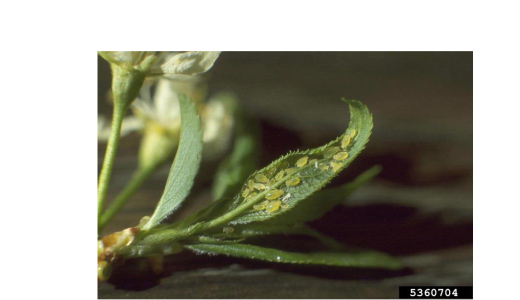
Managing Aphids in Landscape Trees and Shrubs
With a tough winter behind us, our landscapes have a lot of stressed trees and shrubs this year, and the Schutter Diagnostic Lab has received several samples and questions about aphids in landscape trees and shrubs. Stressed plants can be more susceptible to pest issues, such as aphids, and can be further stressed by these insects. These sap-sucking insects can cause curling, distortion, discoloration, and overall lack of vigor in plants.
Healthy and established trees and shrubs can usually withstand some aphid feeding without many issues. In addition, many beneficial insects such as predators and parasitoids can keep aphid populations in check. Therefore, management strategies for aphids should keep these beneficial insects in mind, and limit the use of products that can harm them.
Ants can have a mutualistic relationship with aphids, where they use the honeydew produced by these insects, and protect them from natural enemies. Sometimes, the presence of ants on landscape trees and shrubs can indicate the presence of aphids. Placing a cardboard wrap around the base of trees, coated with a sticky substance (like Tanglefoot) can prevent ants from climbing up to protect aphids, making the jobs of these beneficial insects easier.
Vigorously growing and recently fertilized plants often have higher aphid populations due to the production of new succulent growth. If you use fertilizers, use those that are slow release, and reduce the amount used in situations with aphid infestations.
 Green Peach Aphids (Photo: Eugene E. Nelson, Bugwood.org) |
Aphids are often pretty sensitive insects and don't like humid environments. Depending on the severity of infestation, they can be managed using a strong stream of water to physically knock them off the trees, which can reduce their numbers and help beneficial insects keep their populations under control. Using this strategy multiple times to reduce initial populations can help to control the infestation (though it may take some time and repeated water spraying).
If the water spray method doesn't work, there are many products labeled for aphid control. Contact insecticides such as insecticidal soaps and summer horticultural oils can be used as foliar sprays during aphid outbreaks, but these are more challenging to use in larger trees because they need to coat the surface of the aphid in order to work, and these insects are often protected by the foliage because they are found on the underside of leaves. In addition, unless professional equipment is used, it is difficult to get the insecticide to reach fully within the trees. It may be beneficial to hire a professional for insecticide application if the water spray method doesn't produce results. It is also important to be cautious when using horticultural oils on sensitive plants, especially when temperatures are high, as these can burn foliage.
Systemic insecticides with active ingredients such as imidacloprid and dinotefuran can be another option in situations where complete coverage with contact insecticides can be difficult, and to protect new growth over time (make sure to use products labeled for appropriate use, and always read and follow label directions).
Sooty Mold
With aphid infestations, we also see honeydew production (which is a sticky substance excreted by some insects, including aphids). This sugar-rich substance can host a secondary infestation of a dark greyish-black fungus known as sooty mold.
 Sooty Mold (Photo: Joseph OBrien, USDA Forest Service, Bugwood.org) |
Although sooty mold doesn't actively infect the plants themselves (and instead, is only found on plant surfaces), significant amounts of it can reduce photosynthesis and cause premature leaf drop. Addressing the underlying problem of aphids can help to reduce this issue.
Disclaimer: These recommendations are provided only as a guide. It is always the pesticide applicator's responsibility, by law, to read and follow all current label directions for the specific pesticide being used. If any information in these recommendations disagrees with the label, the recommendation must be disregarded. No endorsement is intended for products mentioned. The authors and Montana State University assume no liability resulting from the use of these recommendations.
Abiya (Abi) Saeed
[email protected]